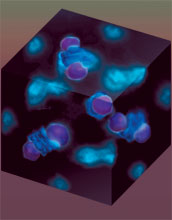Multimedia Gallery
Cuprite Compound Blue
This image is one of the first ever taken of atomic bonding. The image shows the electronic bonds that hold together atoms of oxygen and copper in a compound called cuprite. [See Related Image.]
More about this Image
In January 1999, John Spence, a regents professor of physics, led a team of Arizona State University scientists in producing the first-ever real-time images of atomic bonding. Spence and his team--research scientists Jian-Min Zuo, Moon Kim and Michael O'Keeffe--used x-ray scattering and electron diffraction techniques to capture direct images of the electronic bonds that hold together atoms of oxygen and copper in a compound called cuprite. In this image--which is real and not a computer simulation--you can see the dumbbell-shaped clouds of electrons that are shared between copper and oxygen atoms in cuprite (Cu20).
This image represents the first time the covalent bonds between atoms have ever been "seen" in cuprite. The invisible nuclei of the copper atoms are at the center of the dumbbells. Nuclei of the oxygen atoms are located at the center and corners of the superimposed cube. The fuzzy green clouds are less-defined electron clouds representing covalent bonds between the copper atoms.
Many chemists do not believe that such metal-to-metal bonding can occur in this material. Cuprite is a superconductor and like many similar metal oxides, it has strange electrical properties that may now be explained by these never-before-seen bonds. The work may have broad implications for new materials used in computer compounds, medical equipment and other devices.
The National Science Foundation (NSF) supports this and other research projects at Arizona State University's Center for High Resolution Electron Microscopy, a Materials Research Science and Engineering Center. The complete findings of this work were published in the Sept. 2, 1999, issue of the journal Nature.
(Note: The ASU MRSEC was supported by NSF at the time this research was performed.) (Year of image: 1999)
Credit: ASU Research Magazine
Images and other media in the National Science Foundation Multimedia Gallery are available for use in print and electronic material by NSF employees, members of the media, university staff, teachers and the general public. All media in the gallery are intended for personal, educational and nonprofit/non-commercial use only.
Images credited to the National Science Foundation, a federal agency, are in the public domain. The images were created by employees of the United States Government as part of their official duties or prepared by contractors as "works for hire" for NSF. You may freely use NSF-credited images and, at your discretion, credit NSF with a "Courtesy: National Science Foundation" notation.
Additional information about general usage can be found in Conditions.
Also Available:
Download the high-resolution TIFF version of the image. (39.7 MB)
Use your mouse to right-click (Mac users may need to Ctrl-click) the link above and choose the option that will save the file or target to your computer.

